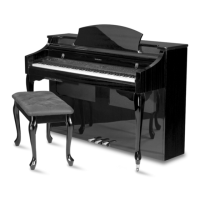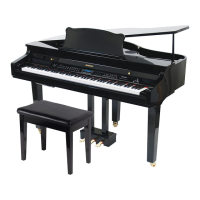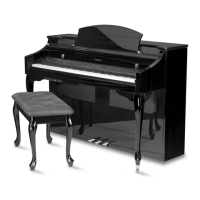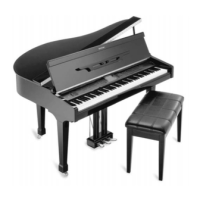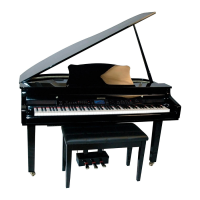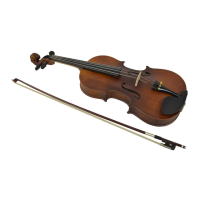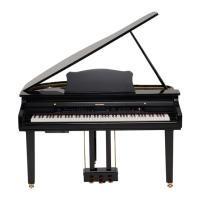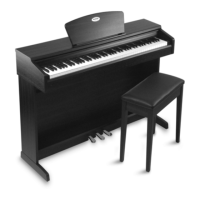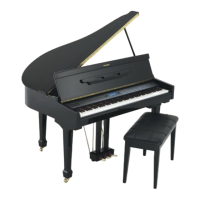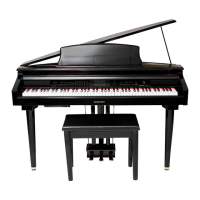Do you have a question about the Suzuki SS-100 and is the answer not in the manual?
Information on reducing electric shock risk and FCC compliance for digital devices.
Procedures for servicing, handling, and transporting the piano safely.
Instructions for cleaning the piano and optimal placement for longevity.
Guidelines for turning the unit on/off and power cord safety.
Detailed steps for assembling the piano stand legs and attaching components.
Steps for assembling side boards, cross boards, and the main piano stand.
Attaching the piano to the stand and initial power-up sequence.
Adjusting Master Volume and Accompaniment Volume.
Setting tempo and using the auto harmony feature.
Using Layer (dual) and Lower (split) voice modes.
Starting rhythm styles via Straight, Intro, or Sync Start.
Managing rhythm introductions, endings, fill-ins, and variations.
Engaging and configuring the auto accompaniment section.
Using A/B, Quick Select Voice, and Quick Select Style buttons.
Selecting Percussion, Instrument Voice, and Rhythm Styles.
Using the built-in songs for learning and practice.
Accessing and navigating the Function menu.
Storing settings in User Registration and using Numeric Pad.
Using Transpose, Reverb, and Chorus effects.
Practicing songs and using recording features.
Operating the recording and playback functions.
Playing back built-in demonstration songs.
Smoothly raising or lowering the pitch of played notes.
Adding vibrato effect to played notes.
Playing back all or individual demonstration songs.
Overview of selecting voices via quick select and numeric input.
Assigning user voices and using Layer/Split modes.
Changing the split point for the lower voice section.
Selecting from 100 rhythm styles and variations.
Assigning user styles and adjusting tempo.
Using Straight, Intro, or Synchronized Start for rhythms.
Managing rhythm variations, fills, and auto accompaniment split point.
Using Auto Bass Chord with Single, Fingered, or Piano modes.
Playing chords anywhere on the keyboard for accompaniment.
Using Piano mode, Manual Bass Chord, and Auto Harmony.
Using Straight, Intro, or Synchronized Start for accompaniment.
Managing auto accompaniment variations, fills, and split points.
Steps to access and change parameters within the function menu.
Adjusting metronome and reverb level parameters.
Adjusting chorus level and selecting touch sensitivity.
Changing split points for voice and auto accompaniment.
Adjusting master tune and selecting drum kits.
Selecting from four types of auto harmony (Duet, Close, Open, Octave).
Steps for preparing, selecting songs, and tracks for recording.
Recording melody, accompaniment, or both; and stopping recording.
Listening to recorded songs and tracks.
Saving current settings and recalling saved memories.
Engaging the song mode and selecting songs for practice.
Connecting to external MIDI devices using IN and OUT ports.
Understanding MIDI channels for voice, percussion, and other functions.
Connecting MIDI devices and outputting audio signal.
Connecting volume pedals, sustain pedals, and headphones.
Using the volume and sustain pedals for control.
Information on reducing electric shock risk and FCC compliance for digital devices.
Procedures for servicing, handling, and transporting the piano safely.
Instructions for cleaning the piano and optimal placement for longevity.
Guidelines for turning the unit on/off and power cord safety.
Detailed steps for assembling the piano stand legs and attaching components.
Steps for assembling side boards, cross boards, and the main piano stand.
Attaching the piano to the stand and initial power-up sequence.
Adjusting Master Volume and Accompaniment Volume.
Setting tempo and using the auto harmony feature.
Using Layer (dual) and Lower (split) voice modes.
Starting rhythm styles via Straight, Intro, or Sync Start.
Managing rhythm introductions, endings, fill-ins, and variations.
Engaging and configuring the auto accompaniment section.
Using A/B, Quick Select Voice, and Quick Select Style buttons.
Selecting Percussion, Instrument Voice, and Rhythm Styles.
Using the built-in songs for learning and practice.
Accessing and navigating the Function menu.
Storing settings in User Registration and using Numeric Pad.
Using Transpose, Reverb, and Chorus effects.
Practicing songs and using recording features.
Operating the recording and playback functions.
Playing back built-in demonstration songs.
Smoothly raising or lowering the pitch of played notes.
Adding vibrato effect to played notes.
Playing back all or individual demonstration songs.
Overview of selecting voices via quick select and numeric input.
Assigning user voices and using Layer/Split modes.
Changing the split point for the lower voice section.
Selecting from 100 rhythm styles and variations.
Assigning user styles and adjusting tempo.
Using Straight, Intro, or Synchronized Start for rhythms.
Managing rhythm variations, fills, and auto accompaniment split point.
Using Auto Bass Chord with Single, Fingered, or Piano modes.
Playing chords anywhere on the keyboard for accompaniment.
Using Piano mode, Manual Bass Chord, and Auto Harmony.
Using Straight, Intro, or Synchronized Start for accompaniment.
Managing auto accompaniment variations, fills, and split points.
Steps to access and change parameters within the function menu.
Adjusting metronome and reverb level parameters.
Adjusting chorus level and selecting touch sensitivity.
Changing split points for voice and auto accompaniment.
Adjusting master tune and selecting drum kits.
Selecting from four types of auto harmony (Duet, Close, Open, Octave).
Steps for preparing, selecting songs, and tracks for recording.
Recording melody, accompaniment, or both; and stopping recording.
Listening to recorded songs and tracks.
Saving current settings and recalling saved memories.
Engaging the song mode and selecting songs for practice.
Connecting to external MIDI devices using IN and OUT ports.
Understanding MIDI channels for voice, percussion, and other functions.
Connecting MIDI devices and outputting audio signal.
Connecting volume pedals, sustain pedals, and headphones.
Using the volume and sustain pedals for control.
| Brand | Suzuki |
|---|---|
| Model | SS-100 |
| Category | Musical Instrument |
| Language | English |
